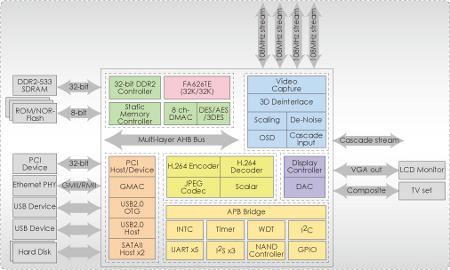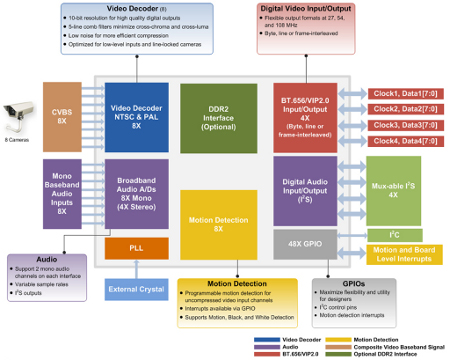Surveillance DVR reference design runs Linux
Nov 4, 2010 — by Eric Brown — from the LinuxDevices Archive — 72 viewsFabless semiconductor firm Conexant and Taiwan-based system-on-chip (SoC) design company Grain Media announced a Linux-based hardware/software platform for video, image processing, and surveillance applications. Intended for creation of 16-channel digital video recorders (DVRs), the reference design combines Conexant's CX25838 multichannel video decoders and Grain Media's ARM-based GM8186/GM8187 SoC, which specializes in H.264 compression.
The jointly developed reference design targets the development of video surveillance DVRs that support 16-channel encoding, recording and playback, as well as providing dual- or triple-display output, according to Conexant (which appears to be the primary vendor for the design).
Key features include support for embedded keypad and remote controller functionality, "without the need for an external micro-controller," says Newport Beach, Calif. based Conexant. The design also offers "a single crystal for full system operation," says the company.
The design platform runs embedded Linux on a GM8186/GM8187 H.264 SoC from Grain Media, based in Taiwan. The 540MHz CPU supports DDR2 memory up to 810MHz, and is claimed to enable "high-quality video performance with low bit rates." The SoC has been optimized for 16-channel DVR systems, says Conexant.
Grain Media offered no more details on the GM8186/GM8187, but the SoC appears to be based on its GM8181 SoC (see block diagram below). The GM8181 features a 533MHz ARM9 core from Faraday Technology called the FA626TE.

Block diagram for the Grain Media GM8181, the apparent foundation for the GM8186/GM8187
I/O includes a SATA controller, SATA-II PHY, USB 2.0 OTG controller, USB 2.0 PHY, and an Ethernet GMAC controller, says the company.
The jointly developed surveillance reference design also integrates two Conexant CX25838 video decoders, which "deliver the industry's lowest power consumption and heat dissipation per channel" while "minimizing noise and facilitating low compression bit rates," claims Conexant.

Conexant CX25838 block diagram
(Click to enlarge)
The reference platform supports multiple peripheral interfaces, including SATA 2.0, USB OTG and Host, key scan, and a remote controller, says Conexant. Multiple-display video is said to be supported with HDMI, VGA, and NTSC/PAL display outputs. The platform also includes a PCI interface to support add-on video analytics cards, according to the company.
Stated Phil Pompa, senior vice president of product marketing for Conexant, "Our jointly developed reference design allows manufacturers to quickly develop high-density video surveillance and security products for this growing market segment. Working with Grain Media also allows us to reach and serve a broader customer base."
Stated Raymond Lai, director of sales and product marketing at Grain Media, "The co-development project with Conexant enables us to provide our customers with the best system architecture for high channel surveillance equipment."
Availability
The unnamed hardware/software reference platform for surveillance DVR applications is available now, says Conexant. More information on Conexant's CX25838 may be found here.
More on Grain Media's GM8181 H264 codec SoC, which appears to be similar to the new GM8186/GM8187 SoC used in the reference platform, may be found here.
This article was originally published on LinuxDevices.com and has been donated to the open source community by QuinStreet Inc. Please visit LinuxToday.com for up-to-date news and articles about Linux and open source.